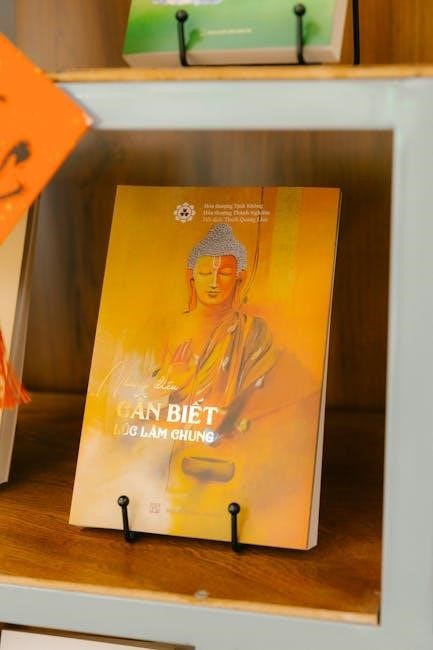Anthony Burgess’s A Clockwork Orange is a dystopian novel exploring themes of free will, morality, and societal conditioning. Its futuristic setting and unique Nadsat slang captivate readers, while its controversial themes spark debates on ethics and human nature. The PDF version offers a convenient way to engage with this thought-provoking story, complete with a glossary and insightful notes.
1.1 Overview of the Novel
A Clockwork Orange is a dystopian novel by Anthony Burgess, set in a futuristic Britain. It follows Alex, a charismatic teenager who leads a gang of “droogs” in acts of ultra-violence. The story explores themes of free will, morality, and societal control as Alex is caught and subjected to psychological conditioning. The novel is written in Nadsat, a slang language blending English and Russian, which adds to its unique and immersive atmosphere. The PDF version of the novel includes a glossary of Nadsat terms, making it easier for readers to understand and engage with Burgess’s vision of a morally complex, futuristic world.
1.2 Historical Context and Publication
A Clockwork Orange was published in 1962 by Anthony Burgess, set against the backdrop of a dystopian Britain. The novel’s exploration of free will and societal control resonated with Cold War-era anxieties. Initially met with mixed reviews, it gained notoriety for its violent themes and unique Nadsat slang. The PDF version includes a glossary of Nadsat terms, enhancing accessibility. The novel was later banned in some regions due to its graphic content. Its controversial reputation grew with Stanley Kubrick’s 1971 film adaptation, cementing its cultural impact. The PDF edition offers a comprehensive reading experience, including historical context and insights into Burgess’s vision;
1.3 Author Anthony Burgess and His Vision
Anthony Burgess, a multifaceted writer with a passion for music and linguistics, crafted A Clockwork Orange to explore the tension between free will and societal conditioning. His vision delved into the moral complexities of a dystopian world, where violence and aesthetics intertwine. Burgess’s use of Nadsat slang reflects his fascination with language evolution. The PDF edition of the novel includes insights into his creative process, revealing his intent to provoke thought on human nature and ethical dilemmas. Burgess’s work remains a profound commentary on individuality and conformity, resonating with readers seeking deeper philosophical engagement.

Themes and Motifs in “A Clockwork Orange”
The novel explores free will, morality, and societal conditioning, with a focus on violence’s aestheticization and the struggle between individuality and conformity in a dystopian world.
2.1 The Concept of Free Will
The novel delves deeply into the concept of free will, questioning whether it is better to choose evil freely or to be conditioned to do good. Alex, the protagonist, embodies a Nietzschean ideal of self-becoming, thriving in his violent nature. The Ludovico technique, which forces moral behavior, strips him of his free will, raising ethical dilemmas. Burgess argues that true humanity lies in the ability to choose, even if those choices are flawed. The PDF version of the novel highlights these themes, emphasizing the tension between organic human nature and mechanical conditioning, ultimately suggesting that forced morality undermines genuine ethical growth.
2.2 Morality and Ethics in a Dystopian Society

The novel critiques the moral fabric of a dystopian society, where violence and decay are rampant. Alex’s actions challenge societal norms, while the state’s response—conditioning him to reject violence—raises ethical questions. The preacher, a moral voice, advocates for redemption through free will, contrasting with the mechanical morality imposed by the Ludovico technique. Burgess explores whether forced ethical behavior is truly moral or merely a superficial solution. The PDF version of the novel underscores these themes, highlighting the tension between societal control and individual ethical choice, ultimately questioning the validity of morality without genuine freedom.
2.3 Violence and Its Aestheticization
In A Clockwork Orange, violence is depicted as a form of artistic expression, particularly through Alex’s appreciation for “ultra-violence” and classical music. The novel explores how violence can be romanticized, with Alex and his droogs finding beauty in their brutal acts. This aestheticization of violence raises questions about its societal impact and the morality of glorifying such behavior. The PDF version of the novel highlights Burgess’s critique of a society that both condemns and fascinates itself with violence, challenging readers to reflect on the ethical implications of such duality.
2.4 The Struggle Between Individuality and Conformity

In A Clockwork Orange, the struggle between individuality and conformity is central, as Alex’s violent free will clashes with societal demands for obedience; The novel critiques forced conformity, as seen in the Ludovico technique, which strips Alex of his autonomy. Burgess argues that true individuality cannot be erased, as Alex ultimately reverts to his natural state. The PDF version of the novel emphasizes this theme, highlighting how societal conditioning can undermine humanity. The tension between personal freedom and external control remains a powerful commentary on the importance of preserving individuality in a conformist world.

The Futuristic World of “A Clockwork Orange”
The novel portrays a dystopian society with advanced technology used to suppress desires, blending brutality with futuristic mechanisms. The PDF version vividly captures this unsettling, high-tech world.

3.1 The Setting and Its Significance
The futuristic world of A Clockwork Orange is a dystopian society where technological advancements coexist with societal decay. The setting, a bleak, urban landscape, reflects themes of free will and morality. The PDF version of the novel enhances the reader’s immersion into this unsettling environment, with its detailed descriptions and Burgess’s unique Nadsat slang. The setting serves as a backdrop for exploring the tension between individuality and societal control, highlighting the consequences of conditioning human behavior. This futuristic world critiques the potential dangers of a society that prioritizes order over freedom.
3.2 Technological Advancements and Their Implications
The novel explores a futuristic society where technological advancements are deeply intertwined with societal control. The Ludovico technique, a behavior modification method, exemplifies how technology is used to suppress free will. This mechanism, while aiming to reduce violence, raises ethical questions about the morality of conditioning individuals. The PDF version of A Clockwork Orange highlights these themes through detailed descriptions and annotations, offering readers a deeper understanding of the implications of such technologies. The tension between technological progress and human autonomy is central to the novel’s critique of a society that values order over individual freedom.
3.3 The Role of Society in Shaping Behavior
In A Clockwork Orange, society plays a pivotal role in shaping behavior through conditioning and control. The novel depicts a dystopian world where the state employs technological methods, like the Ludovico technique, to suppress violence but at the cost of free will. The PDF version highlights how societal pressures and conditioning can transform individuals into conformists, losing their autonomy. This exploration raises questions about the balance between order and individuality, emphasizing how societal structures can influence moral and ethical choices. The novel critiques the idea of a society that prioritizes control over personal freedom, leaving readers to ponder the consequences.
Character Analysis
Alex, the charismatic protagonist, evolves from a violent delinquent to a conditioned victim of societal control. His Droogs embody loyalty and chaos, while the preacher offers moral contrast, highlighting the novel’s ethical dilemmas.
4.1 Alex: The Protagonist and His Evolution
Alex, the novel’s protagonist, is a complex and dynamic character whose evolution drives the narrative. Initially, he is a violent, free-willed teenager who finds beauty in chaos and classical music, particularly Beethoven. His journey begins with ultra-violence and moral ambiguity, reflecting a Nietzschean ideal of self-becoming. After undergoing the Ludovico technique, a form of psychological conditioning, Alex loses his free will, forced into a mechanical morality. However, this transformation is superficial, as he reverts to his true nature by the end, highlighting the tension between organic human behavior and societal control. His story underscores the novel’s exploration of free will and identity.
4.2 The Droogs: Their Role and Dynamics
The Droogs, Alex’s gang, are central to the novel’s exploration of violence and societal dysfunction. Their dynamics revolve around a hierarchical structure, with Alex as the charismatic leader. The Droogs embody the novel’s themes of free will and moral decay, engaging in ultra-violence as a form of self-expression. Their actions reflect a society that fosters brutality, while their camaraderie highlights a twisted sense of loyalty. As the story progresses, the Droogs’ unity fractures, mirroring the broader tension between individuality and conformity. Their role underscores the novel’s critique of a dystopian world where youth rebellion spirals into chaos.
4;3 The Preacher: A Moral Counterpoint
The Preacher stands as a moral counterpoint in the novel, advocating for humanity and redemption. Unlike the oppressive societal forces, he believes in Alex’s capacity for genuine moral growth. The Preacher’s arguments emphasize the importance of free will, criticizing the conditioning that strips individuals of their autonomy. His perspective contrasts sharply with the dystopian society’s reliance on control and conformity. Through his character, Burgess highlights the tension between forced morality and true ethical transformation, making the Preacher a pivotal figure in the novel’s exploration of human nature and societal ethics.
The “Clockwork Orange” Metaphor
The title symbolizes the tension between organic humanity and mechanical control, reflecting Alex’s forced transformation and societal conditioning, questioning free will’s essence in a controlled world.
5.1 The Title’s Symbolism Explained
The title A Clockwork Orange symbolizes the clash between organic humanity and mechanical control. A “clockwork” object is artificial, programmed, and devoid of free will, while an “orange” represents natural life and vitality. This metaphor reflects Alex’s transformation from a violent, free-willed individual to a conditioned, morally enforced being. The novel explores whether true morality can exist without free will, using the title to highlight the tension between human autonomy and societal conditioning. This duality underscores the novel’s central theme of ethical choice in a controlled world.
5.2 The Tension Between Organic and Mechanical
The novel explores the tension between organic humanity and mechanical control, symbolized by the title. The “orange” represents natural, vibrant life, while “clockwork” signifies rigid, programmed behavior. Alex’s journey reflects this duality, as he transitions from a violent, free-willed individual to a conditioned, morally enforced being. The government’s conditioning seeks to replace his organic impulses with mechanical obedience, raising questions about the ethics of forced morality. This tension highlights the novel’s central conflict: the loss of free will in a society that values order over individuality, ultimately questioning what it means to be human.
The Novel’s Controversy and Legacy
A Clockwork Orange faced censorship and bans due to its graphic violence, yet its exploration of free will and morality remains influential. The 1971 film adaptation, directed by Stanley Kubrick, further amplified its cultural impact, sparking debates on ethics and societal control. The novel’s legacy endures as a thought-provoking commentary on human nature and conditioning.
6.1 Censorship and Banned Status
A Clockwork Orange has faced significant censorship due to its graphic violence and morally complex themes. The novel was banned in several countries upon its release, with critics labeling it as obscene. The 1971 film adaptation further fueled controversy, leading to restrictions in various regions. Despite this, the novel’s exploration of free will and societal conditioning has endured, making it a pivotal work in dystopian literature. Its availability in PDF format has ensured its accessibility, allowing readers to engage with its provocative ideas and reflect on its relevance to modern ethical debates.
6.2 Cultural Impact and Adaptations
A Clockwork Orange has left an indelible mark on popular culture. Stanley Kubrick’s 1971 film adaptation became iconic, earning four Oscar nominations and cementing the novel’s status as a cultural phenomenon. The story’s themes of free will and societal control continue to resonate, influencing music, film, and literature. The PDF version of the novel remains widely read, introducing new generations to its unique Nadsat language and dystopian vision. Its enduring relevance ensures that A Clockwork Orange remains a must-read for those exploring the intersection of morality and individuality in a futuristic society.

The PDF Version of “A Clockwork Orange”
The PDF version of A Clockwork Orange offers a fully restored edition of Anthony Burgess’s original text, complete with a glossary of Nadsat, explanatory notes, and pages from the original typescript, providing readers with a deeper understanding of the novel’s complexities and linguistic innovations.

7.1 Availability and Accessibility

The PDF version of A Clockwork Orange is widely available for download from various online platforms, including major eBook retailers and academic databases. Its digital format ensures accessibility across devices, making it easy for readers to engage with the novel anytime, anywhere. The PDF retains the original text’s integrity, including the unique Nadsat slang, and often includes supplementary materials like a glossary and explanatory notes. This accessibility has made the novel more reachable to a global audience, fostering deeper exploration of its themes and linguistic innovations.
7.2 Features of the Digital Edition
The digital edition of A Clockwork Orange in PDF format offers enhanced readability with adjustable font sizes and night mode for comfortable reading. It includes a comprehensive glossary of Nadsat slang, explanatory notes, and pages from the original typescript, providing deeper insights into Burgess’s creative process. Interviews and critical essays are also featured, enriching the reader’s understanding of the novel’s themes and cultural impact. The PDF is fully searchable, allowing quick access to specific passages or terms, making it a valuable resource for both casual readers and academic study.
7.3 Benefits of Reading the PDF Format
Reading A Clockwork Orange in PDF format offers unparalleled convenience and accessibility. The digital version allows readers to carry the novel across multiple devices, ensuring it is always within reach. Enhanced readability features, such as adjustable font sizes and night mode, cater to individual preferences. The PDF also includes a glossary of Nadsat slang, facilitating easier comprehension of Burgess’s unique language. Additionally, the ability to search and navigate through the text effortlessly makes it ideal for academic or casual reading. This format preserves the original content while offering a modern, eco-friendly way to engage with the classic novel.
A Clockwork Orange remains a powerful exploration of free will and societal conditioning. The PDF version offers convenient access, enhancing reader engagement with this timeless classic effectively.

8.1 Summary of Key Points
A Clockwork Orange delves into themes of free will, morality, and societal conditioning, set in a dystopian future. The novel explores Alex’s transformation, questioning the ethics of forced behavioral modification. Its unique Nadsat slang and futuristic setting enhance its exploration of violence and individuality. The PDF version provides easy access to Burgess’s original text, including a glossary and notes, making it a valuable resource for understanding the novel’s complex themes. The story challenges readers to reflect on the tension between organic human nature and mechanical control, emphasizing the importance of personal choice and autonomy.
8.2 Final Thoughts on the Novel’s Relevance
A Clockwork Orange remains a timeless exploration of free will, morality, and societal control. Its themes resonate today, urging readers to reflect on the balance between individual freedom and external conditioning. The novel’s futuristic setting and philosophical depth continue to provoke thought about human nature and ethical dilemmas. The PDF version enhances accessibility, offering a convenient way to engage with Burgess’s profound commentary on violence, redemption, and the complexities of human choice. Its relevance endures, making it a vital read for understanding the tensions between personal autonomy and societal expectations in both past and present.